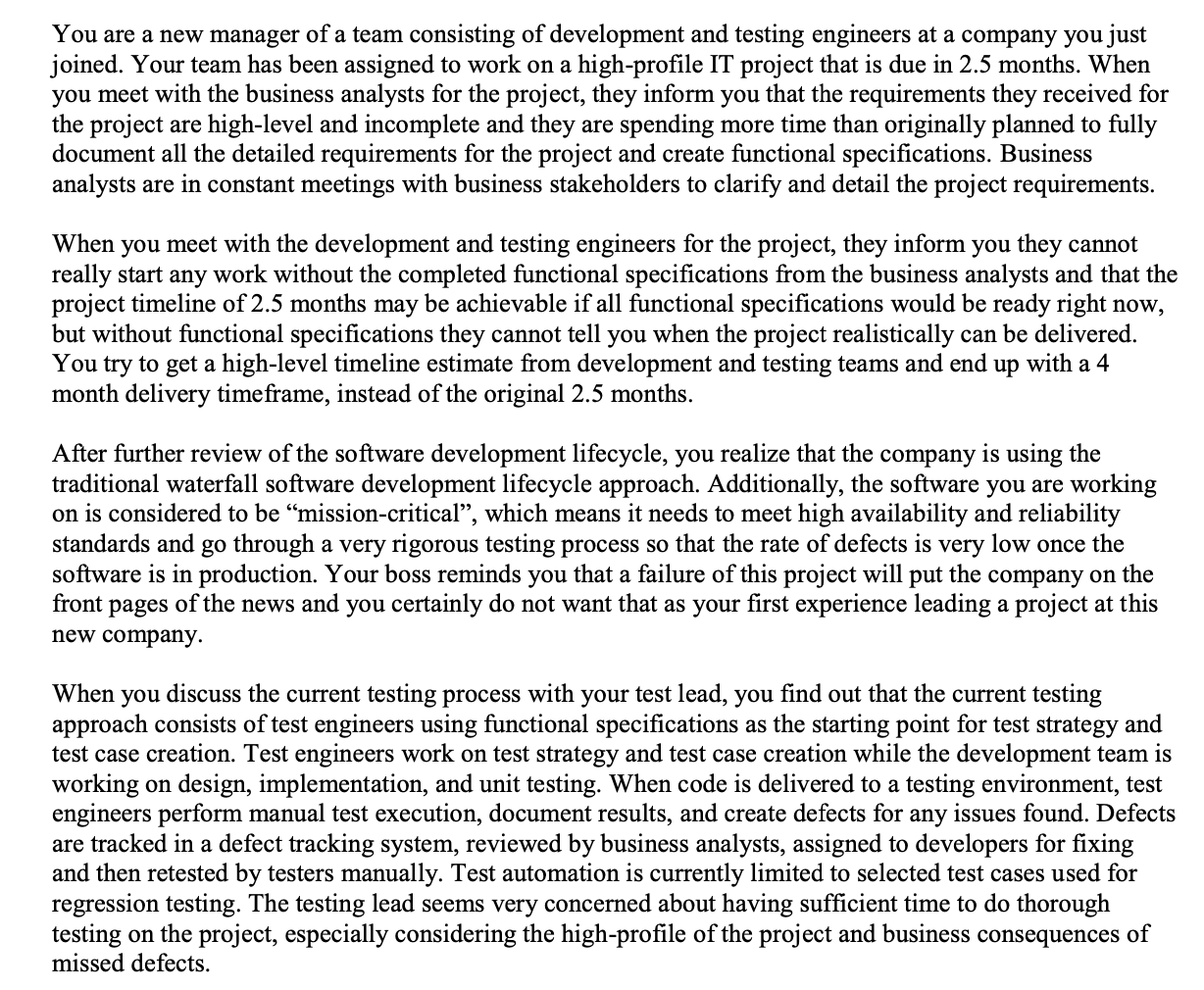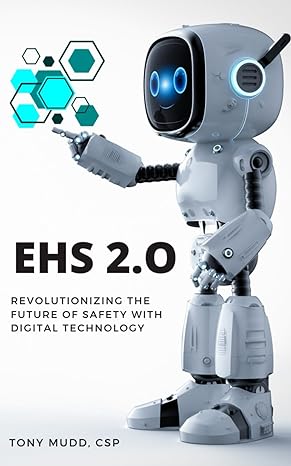Question
Case Study on Testing Processes and Software Development Lifecycle Your Challenge: What strategy can you take as a manager of this software project to ensure
Case Study on Testing Processes and Software Development Lifecycle
Your Challenge: What strategy can you take as a manager of this software project to ensure successful delivery of the software?
Please consider the following topics in your response:
What software development lifecycle model do you think is the most appropriate in this case?
-
Can you radically change the way the team has been working and introduce a new software development lifecycle model to speed up project delivery?
-
Would a development lifecycle change be too much of a distraction and challenge on a team already stressed on an important project that is running late?
-
What development and testing best practices can you add to the current processes on the team to speed up delivery and improve quality?
-
How can we speed up the process of discovery of business requirements and their detailed documentation through functional specification?
-
How can we get various team members (business analysts, developers, testers) to better collaborate with each other instead of working in silos?
-
What testing-related tools would be needed for this project?
-
What testing phases are necessary for this project?
-
Who should be involved in different testing phases in addition to the testing engineers?
-
Can you possibly deliver the project within the original timeline of 2.5 months? If not, what strategy can you try to negotiate a project extension with the project stakeholders?
Create your response to this challenge as a proposal you will submit to your boss. Document the current issues on the project that you think are putting the project at risk for on-time, quality delivery. Provide a new strategy (or several alternative strategies) that will address these issues and you think will bring the project to a successful delivery. Explain the potential risks as well as pros and cons of your strategy (or strategies). If you are proposing multiple alternatives, provide a recommendation for your preferred approach.
Format your response as an APA paper and include a bibliography with references/sources you have consulted in preparing your proposal.
You are a new manager of a team consisting of development and testing engineers at a company you just joined. Your team has been assigned to work on a high-profile IT project that is due in 2.5 months. When you meet with the business analysts for the project, they inform you that the requirements they received for the project are high-level and incomplete and they are spending more time than originally planned to fully document all the detailed requirements for the project and create functional specifications. Business analysts are in constant meetings with business stakeholders to clarify and detail the project requirements. When you meet with the development and testing engineers for the project, they inform you they cannot really start any work without the completed functional specifications from the business analysts and that the project timeline of 2.5 months may be achievable if all functional specifications would be ready right now, but without functional specifications they cannot tell you when the project realistically can be delivered. You try to get a high-level timeline estimate from development and testing teams and end up with a 4 month delivery timeframe, instead of the original 2.5 months. A further review of the software development lifecycle, you realize that the company is using the traditional waterfall software development lifecycle approach. Additionally, the software you are working on is considered to be mission-critical, which means it needs to meet high availability and reliability standards and go through a very rigorous testing process so that the rate of defects is very low once the software is in production. Your boss reminds you that a failure of this project will put the company on the front pages of the news and you certainly do not want that as your first experience leading a project at this new company. When you discuss the current testing process with your test lead, you find out that the current testing approach consists of test engineers using functional specifications as the starting point for test strategy and test case creation. Test engineers work on test strategy and test case creation while the development team is working on design, implementation, and unit testing. When code is delivered to a testing environment, test engineers perform manual test execution, document results, and create defects for any issues found. Defects are tracked in a defect tracking system, reviewed by business analysts, assigned to developers for fixing and then retested by testers manually. Test automation is currently limited to selected test cases used for regression testing. The testing lead seems very concerned about having sufficient time to do thorough testing on the project, especially considering the high-profile of the project and business consequences of missed defects. You are a new manager of a team consisting of development and testing engineers at a company you just joined. Your team has been assigned to work on a high-profile IT project that is due in 2.5 months. When you meet with the business analysts for the project, they inform you that the requirements they received for the project are high-level and incomplete and they are spending more time than originally planned to fully document all the detailed requirements for the project and create functional specifications. Business analysts are in constant meetings with business stakeholders to clarify and detail the project requirements. When you meet with the development and testing engineers for the project, they inform you they cannot really start any work without the completed functional specifications from the business analysts and that the project timeline of 2.5 months may be achievable if all functional specifications would be ready right now, but without functional specifications they cannot tell you when the project realistically can be delivered. You try to get a high-level timeline estimate from development and testing teams and end up with a 4 month delivery timeframe, instead of the original 2.5 months. A further review of the software development lifecycle, you realize that the company is using the traditional waterfall software development lifecycle approach. Additionally, the software you are working on is considered to be mission-critical, which means it needs to meet high availability and reliability standards and go through a very rigorous testing process so that the rate of defects is very low once the software is in production. Your boss reminds you that a failure of this project will put the company on the front pages of the news and you certainly do not want that as your first experience leading a project at this new company. When you discuss the current testing process with your test lead, you find out that the current testing approach consists of test engineers using functional specifications as the starting point for test strategy and test case creation. Test engineers work on test strategy and test case creation while the development team is working on design, implementation, and unit testing. When code is delivered to a testing environment, test engineers perform manual test execution, document results, and create defects for any issues found. Defects are tracked in a defect tracking system, reviewed by business analysts, assigned to developers for fixing and then retested by testers manually. Test automation is currently limited to selected test cases used for regression testing. The testing lead seems very concerned about having sufficient time to do thorough testing on the project, especially considering the high-profile of the project and business consequences of missed defects
Step by Step Solution
There are 3 Steps involved in it
Step: 1

Get Instant Access to Expert-Tailored Solutions
See step-by-step solutions with expert insights and AI powered tools for academic success
Step: 2

Step: 3

Ace Your Homework with AI
Get the answers you need in no time with our AI-driven, step-by-step assistance
Get Started


